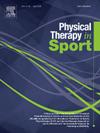Measuring eccentric hip adductor strength during the Copenhagen adduction exercise: A proof-of-concept and test re-test reliability study
IF 2.2
3区 医学
Q1 REHABILITATION
引用次数: 0
Abstract
Objectives
To describe a novel method for measuring eccentric hip adductor (EHAD) strength during the Copenhagen adduction exercise (CAE) and investigate the test re-test reliability of this measure.
Design
Test re-test reliability study.
Participants
Twenty male athletes aged 24 ± 6 years participated in two data collection sessions 7 ± 2 days apart.
Main outcome measures
During each data collection session, participants performed three maximal effort repetitions of the CAE with their leg supported by an ankle strap hung from a fixed barbell. We attached a commercially available load cell in-series with the ankle strap to measure peak force in Newtons (N) during the eccentric lowering phase of the CAE. The intraclass correlation coefficient (ICC), standard error of measurement (SEM), SEM as a percentage of the mean (SEM%) and minimal detectable change at a 95% confidence interval (MDC95) were calculated for this measure of EHAD strength.
Results
Test re-test reliability was good for EHAD strength measured during the CAE on dominant (ICC = 0.84; SEM% = 3.6%; MDC95 = 33 N) and non-dominant (ICC = 0.87; SEM% = 3.3%; MDC95 = 29 N) legs.
Conclusions
This study provides proof-of-concept that EHAD strength can be measured during the CAE with good test re-test reliability.
哥本哈根内收训练中测量偏心髋内收肌力量:概念验证和测试再测试可靠性研究
目的介绍一种在哥本哈根内收运动(CAE)中测量偏心髋内收肌(EHAD)力量的新方法,并探讨该方法的重测可靠性。DesignTest重测可靠性研究。20名男性运动员,年龄24±6岁,参加两次数据收集,间隔7±2天。在每次数据收集过程中,参与者用固定杠铃上挂着的脚踝带支撑腿部,进行三次CAE的最大努力重复。我们将一个市售的称重传感器串联在脚踝带上,以测量CAE偏心下降阶段以牛顿(N)为单位的峰值力。计算了EHAD强度测量的类内相关系数(ICC)、测量标准误差(SEM)、SEM占平均值的百分比(SEM%)和95%置信区间内的最小可检测变化(MDC95)。结果CAE期间测定的EHAD强度的重测信度较好(ICC = 0.84;sem % = 3.6%;MDC95 = 33 N)和非显性(ICC = 0.87;sem % = 3.3%;MDC95 = 29 N)腿。结论本研究提供了概念证明,EHAD强度可以在CAE期间测量,并且具有良好的测试重测信度。
本文章由计算机程序翻译,如有差异,请以英文原文为准。
求助全文
约1分钟内获得全文
求助全文
来源期刊

Physical Therapy in Sport
医学-康复医学
CiteScore
4.50
自引率
8.30%
发文量
125
审稿时长
39 days
期刊介绍:
Physical Therapy in Sport is an international peer-reviewed journal that provides a forum for the publication of research and clinical practice material relevant to the healthcare professions involved in sports and exercise medicine, and rehabilitation. The journal publishes material that is indispensable for day-to-day practice and continuing professional development. Physical Therapy in Sport covers topics dealing with the diagnosis, treatment, and prevention of injuries, as well as more general areas of sports and exercise medicine and related sports science.
The journal publishes original research, case studies, reviews, masterclasses, papers on clinical approaches, and book reviews, as well as occasional reports from conferences. Papers are double-blind peer-reviewed by our international advisory board and other international experts, and submissions from a broad range of disciplines are actively encouraged.
 求助内容:
求助内容: 应助结果提醒方式:
应助结果提醒方式:


